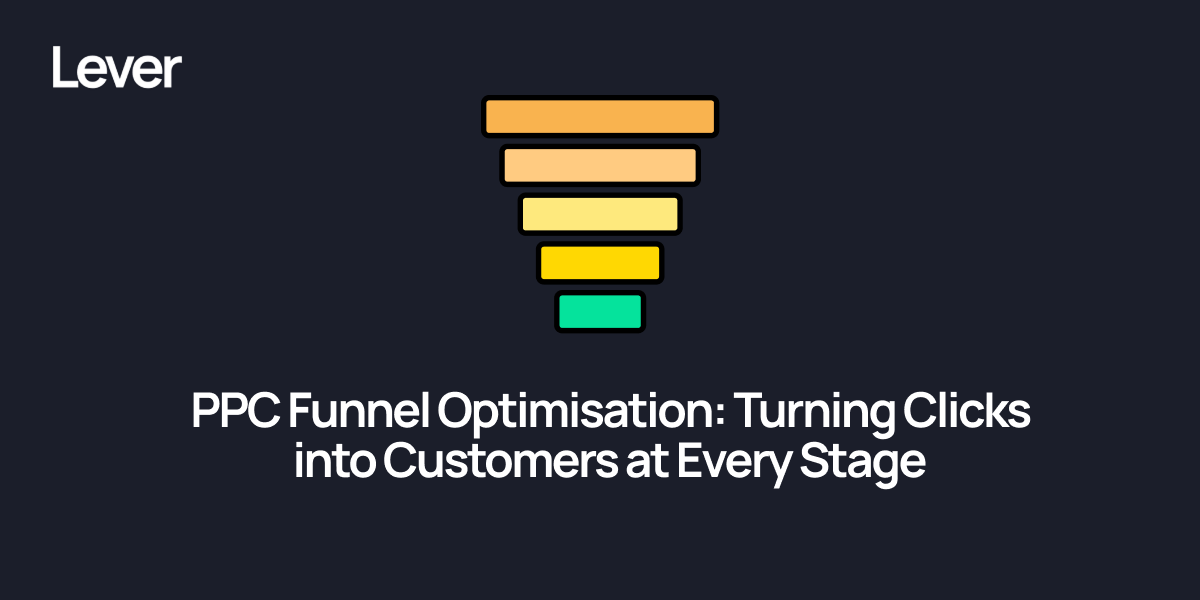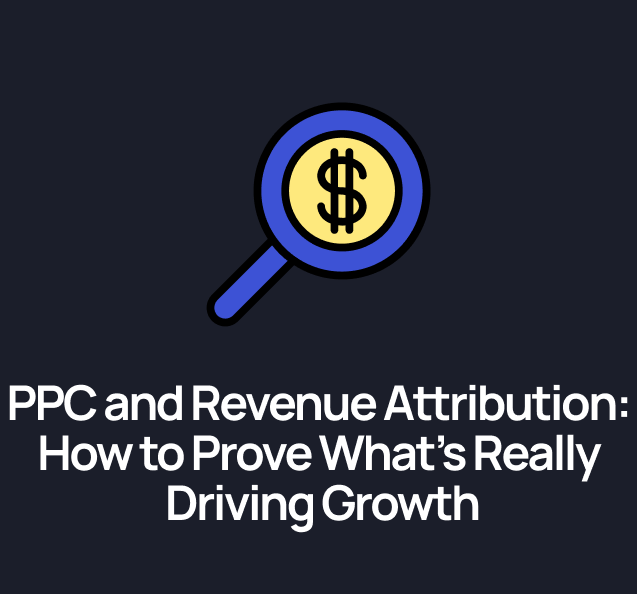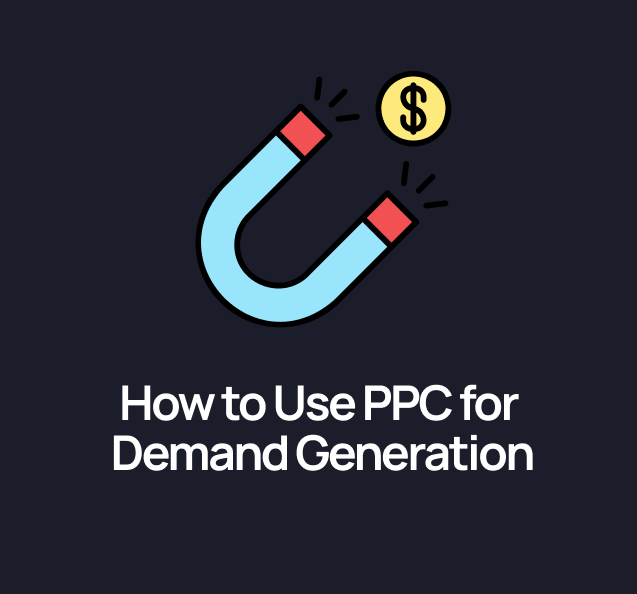If you treat PPC as “let’s bid on some high-intent keywords and hope for the best”, you’ll get exactly that: some leads, some wins, and a lot of shrugging in your pipeline review. In 2025, that’s not good enough.
Around 77% of B2B buyers say they won’t speak to a salesperson until they’ve done their own research, and they’re not doing it on one site either. Ninety per cent of B2B buyers research between two and seven websites before making a purchase, and two-thirds initiate their journey online.
In other words, “optimising PPC” can’t mean tweaking bids once a week and sending everything to a single “Book a demo” page. It has to mean optimising the funnel.
This article will walk you through how to think about PPC as a full-funnel growth system: mapping your real buying journey, aligning campaigns and messaging to each stage, and measuring what actually matters so you can turn more clicks into revenue (not just leads).
1. What we actually mean by “PPC funnel optimisation”
Let’s define terms, because this is where a lot of conversations go sideways.
- PPC: Paid clicks across Google, Microsoft Ads, LinkedIn, Meta, etc. not just search ads.
- Funnel: The actual journey from “I have a problem” to “I’m an active customer who renews and expands”, including messy loops, stalled deals, and committee politics.
- Optimisation: Improving performance stage by stage, not only at the point where someone hits “Submit” on a form.
Why this matters:
- Average Google Ads conversion rates sit around 6–7% across industries. (Source: MIRA)
- But high-value, complex B2B offers usually see lower conversion rates because buyers take longer and involve more stakeholders. (Source: Ruler Analytics)
So if you optimise purely for last-click leads, you’ll:
- Over-invest at the bottom of the funnel.
- Under-fund awareness and education.
- Attract more “form fillers” than qualified opportunities.
- Struggle to explain true PPC impact on pipeline and revenue.
PPC funnel optimisation is about designing campaigns, audiences, and messages intentionally for:
- Problem / awareness
- Solution / category exploration
- Vendor evaluation / selection
- Onboarding, retention, and expansion
…and measuring success appropriately at each stage.

2. Start with reality: map your buying journey, not a textbook funnel
Before touching Google Ads or LinkedIn campaign manager, you need a clear picture of how your buyers actually move.
So, step one: draw the real journey.
Talk to:
- Recent wins and losses.
- Sales leaders and AEs.
- Customer success.
You’re trying to answer:
- How do people first become aware of the problem?
- What triggers them to start actively researching?
- Which questions and objections crop up at each stage?
- Who gets involved when (operator, budget holder, IT, legal, etc.)?
- Where do deals most commonly stall?
That gives you a practical working funnel, for example:
- Problem aware: “Our sales forecasting is a mess” / “We’re blind on paid media ROI.”
- Solution aware: “We might need better attribution / a new PPC agency / a new platform.”
- Vendor aware: Comparing alternatives, building a shortlist, lurking on your site and LinkedIn.
- Validated vendor: Demos, trials, pilots, procurement, security reviews.
- Customer & expansion: Onboarding, adoption, renewal, upsell.
Keep this messy and honest. The job of PPC is not to force a linear journey; it’s to support these stages with the right touchpoints.
3. Align PPC campaigns to each stage of the funnel
Once you understand the journey, you can align campaigns, audiences, and offers.
3.1 Top of funnel: capture problem-aware demand
Goal: Get in front of the right people early and earn attention, not force a demo.
Useful PPC levers:
- Search ads: Non-brand, problem-led queries
- E.g. “how to reduce google ads waste b2b”, “measuring paid media pipeline impact”.
- LinkedIn / Meta: Thought-leadership content targeted by role, industry, company size.
- Microsoft Ads: Often cheaper CPCs on similar queries, especially in B2B.
Offers that make sense:
- In-depth guides and frameworks.
- Benchmarks (e.g. PPC performance benchmarks for their vertical).
- Webinars or on-demand content that solve a specific, painful problem.
KPIs to optimise for:
- Qualified traffic (right geos, industries, company sizes).
- Engagement (scroll depth, time on page, secondary page views).
- Soft conversions: content downloads, newsletter sign-ups.
You’re buying future intent here. Expect lower direct conversion rates, but better performance further down the funnel when you retarget this engaged audience.
3.2 Mid-funnel: help buyers build their shortlist
Here, buyers know roughly what they’re looking for and are trying to work out which approaches and vendors to consider.
PPC levers:
- Search: Category and solution keywords
- E.g. “b2b ppc agency”, “saas google ads management”, “fintech paid media agency”.
- Competitor + comparison queries (used carefully and ethically).
- Remarketing: Warm visitors from TOFU content, segmented by behaviour (e.g. visited pricing, case studies, multiple sessions).
Offers:
- Case studies by industry / use case.
- ROI calculators, planning templates, strategy frameworks.
- “How we work” content that demonstrates your process.
KPIs:
- High-intent content engagement (case studies, pricing, product pages).
- High-fit lead volume (lead scoring or ICP match).
- Sales-accepted leads / opportunities created, not just raw lead counts.
This is where a lot of B2B PPC falls down: campaigns generate MQLs that never convert because the offer and targeting don’t reflect mid-funnel reality. Fixing that is usually worth more than squeezing another 0.3% out of your CTR.
3.3 Bottom-funnel: make it easy to say “yes”
At this point, buyers have a short list and at least one champion internally. Your job is to:
- Show up when they search your brand and close variants.
- Reduce friction between “I’m interested” and “I’ve booked a call / trial”.
- Reassure late-stage stakeholders (finance, IT, procurement).
PPC levers:
- Brand search (protect your own name).
- High-intent generic and competitor terms (with strict negatives to filter out junk).
- Remarketing:
- Visitors who viewed pricing, demo pages, or compared vendors.
- Users who engaged with BOFU content but didn’t convert.
Offers:
- “Book a strategy call” / “Request a proposal”.
- Free audits, projections, or account reviews (with clear scope).
- Trials or pilots, if that fits your model.
KPIs:
- Conversion rate on BOFU pages.
- Pipeline: opportunities created, value, win rate.
- Time-to-opportunity from first BOFU interaction.
Here, conversion rates should be significantly higher than TOFU and MOFU campaigns. If they’re not, you likely have either a messaging mismatch (ad vs landing page) or a form / process issue (too long, too vague, or asking for commitment too early).
3.4 Post-conversion: don’t stop optimising at “lead” or “deal”
Funnel optimisation doesn’t end when the opportunity is marked “Won” in the CRM.
Some of the highest-ROI PPC work sits in:
- Onboarding support: directing new customers to resources that help them get value quickly.
- Cross-sell / upsell: campaigns targeting existing customers with relevant expansions.
- Re-engagement: past opportunities that stalled or churned, where the problem hasn’t gone away.
Tactically, this can look like:
- Customer match lists in Google, Microsoft, and LinkedIn.
- Segmented remarketing for specific product lines or use cases.
- Lifecycle-based messaging (“you’ve been with us X months, here’s what to do next”).
Measurement here is more about net revenue retention and expansion opportunities than standard lead gen KPIs.
4. Match messaging and offers to intent (and to stakeholders)
Because B2B buying groups are large and diverse, often 10–11 stakeholders or more (Source: Corporate Visions), your funnel needs messaging that works for:
- The operator (day-to-day user).
- The budget holder.
- IT / security.
- Procurement or legal.
- The exec sponsor.
You won’t always speak to each one directly via PPC, but you can:
- Use case studies that cover commercial outcomes (CFO), ease of adoption (ops / IT), and long-term value (execs).
- Tailor ad copy to reflect different priorities:
- “Cut wasted ad spend” vs “Prove marketing’s impact on pipeline”.
- Segment remarketing based on pages viewed:
- Pricing page visitors vs reading your technical docs vs careers page visitors (probably not your ICP).
This is where full-funnel thinking pays off. A single “Book a demo” message, shown to everyone at all times, simply can’t do all of this heavy lifting.
5. Rethink measurement: beyond last-click ROAS
It’s tempting to benchmark everything against generic ROAS / CPA targets. But average stats are blunt tools:
- One analysis of conversion rates across multiple industries found an average of 2.9%, with high-ticket industries generally below that figure. (Source: Ruler Analytics)
- Broad Google Ads benchmark studies report conversion rates around 5–7%, but with wide variation by sector. (Source: MIRA)
For complex B2B, that means:
- TOFU and MOFU campaigns may “underperform” if you look only at form fills.
- BOFU campaigns look amazing on paper, while quietly free-riding on all the earlier touchpoints.
A more useful measurement approach:
5.1 Track meaningful actions at each stage
At minimum:
- TOFU: Engaged sessions, content downloads, newsletter sign-ups.
- MOFU: High-intent content consumption (case studies, pricing views), repeat visits, product tours.
- BOFU: Demo / proposal requests, trial sign-ups.
- Post-sale: Product activation, expansion events.
Then connect those to pipeline:
- Track which campaigns and keywords are over-represented in closed-won opportunities, not just MQLs.
- Use your CRM and analytics to calculate cost per opportunity and cost per closed-won.
5.2 Use attribution models that fit the journey
No model is perfect, but some are less misleading than others.
- Last-click only is usually not enough for B2B.
- Data-driven or position-based models can better reflect the reality that it takes multiple touches to convert. Studies across CRO and attribution show that most transactions happen after four or more interactions, which aligns with the idea of a multi-touch journey.
The important bit is consistency: pick a sensible model, understand its biases, and use it to guide optimisation decisions instead of chasing the metric of the week.
6. Finding and fixing leaks at each funnel stage
With the structure and measurement in place, you can start to optimise deliberately.
6.1 Top of funnel leaks
Symptoms:
- Low CTR on problem-led keywords.
- High bounce rates; no secondary page views.
- Very few returning visitors.
Likely issues:
- You’re targeting too broad an audience or irrelevant queries.
- Ad copy doesn’t reflect the actual problem your ICP has.
- Content is either too generic or too product-pitchy for early-stage visitors.
Fixes:
- Tighten your keyword lists and negatives.
- Use language your ICP actually uses in sales calls and Slack messages.
- Offer practical value (frameworks, checklists, benchmarks) without a hard sell.
6.2 Mid-funnel leaks
Symptoms:
- Good traffic from the right ICP, but poor conversion into discovery calls or trials.
- Content downloads that never progress.
- Sales complaining that leads “aren’t ready”.
Likely issues:
- Offers are misaligned with readiness level (only “book a demo” or only “download a guide”).
- Follow-up is weak – no nurture, no retargeting based on behaviour.
- Case studies are too vague or don’t map to their world.
Fixes:
- Introduce intermediate offers: strategy calls, audits, assessments, workshops.
- Build behaviour-based remarketing and email sequences (e.g. viewers of pricing + case study get a specific offer).
- Restructure case studies to highlight the business problem, the approach, and concrete outcomes.
6.3 Bottom-funnel leaks
Symptoms:
- Plenty of demo requests, few opportunities.
- High no-show rates.
- Deals stalling at late stages.
Likely issues:
- You’re attracting “free advice” or mis-fit leads because your ICP isn’t defined tightly enough in campaigns and copy.
- The value proposition on your BOFU pages isn’t strong or specific.
- Stakeholder needs (finance, IT, legal) are not addressed anywhere in the journey.
Fixes:
- Tighten targeting (company size, industry, geo, role) and be explicit in copy about who you are and aren’t for.
- Treat your demo / proposal page like a serious sales asset: social proof, expectations, next steps, FAQs.
- Create assets that help internal champions sell you internally (one-pagers, ROI summaries, security docs).
7. A simple roadmap to start optimising your PPC funnel
If this all sounds like a lot, here’s a pragmatic starting plan you can act on in the next 30–60 days.
Step 1: Audit by funnel stage
- Tag each existing campaign and ad group as TOFU, MOFU, BOFU, or Post-sale.
- Map top-spend keywords, audiences, and landing pages to those stages.
- Highlight where you’re over-weight (usually BOFU search) and under-weight (usually TOFU and MOFU content).
Step 2: Fix measurement basics
- Ensure key actions at each stage are tracked correctly in GA4 / your analytics stack and your ad platforms.
- Connect ad platforms to your CRM so you can see opportunity and revenue impact, not just leads.
- Pick an attribution model and stick with it long enough to learn something.
Step 3: Introduce one strong new offer per stage
For example:
- TOFU: A proper, opinionated guide on a problem your ICP actually has.
- MOFU: A strategy workshop, audit, or calculator tied to that same problem.
- BOFU: A “funnel-first” proposal or roadmap call that outlines what you’d do specifically for them.
Launch (or rework) campaigns around these offers before worrying about marginal bid changes.
Step 4: Build a simple optimisation loop
Every month:
- Look at performance by stage (not just per campaign).
- Identify the biggest leaks.
- Decide 1–2 experiments per stage (messaging, audiences, offers).
- Repeat.
Over time, this compounds. CPCs will rise and algorithms will change regardless; a robust funnel is what keeps your CAC from spiralling.
8. Bringing it back to PPC funnel optimisation
To recap:
- Buyers are researching heavily on their own, across multiple sites, with large internal committees.
- Average PPC benchmarks are just that – averages. Complex B2B funnels behave differently, and that’s normal.
- Treating PPC as a single “lead machine” at the bottom of the funnel leads to the wrong optimisation decisions.
- Funnel-first PPC means aligning keywords, creatives, audiences, offers, and measurement with each stage buyers actually go through.
Done well, PPC becomes less about chasing cheap clicks and more about consistently turning the right clicks into revenue, even when the journey is long and messy.
Want a funnel-first view of your own PPC?
If you’re looking at your current setup and seeing a jumble of campaigns, random audiences, and a single “Contact us” form holding it all together… you’re not alone.
At Lever Digital, we build PPC strategies around your real buying journey, not generic funnel diagrams – and we back it up with clear reporting that connects spend to pipeline.
If you’d like a second opinion, request a free proposal from Lever Digital and we’ll map out how a funnel-first PPC approach could work for your team, your budget, and your revenue targets.

.svg)








.svg)
